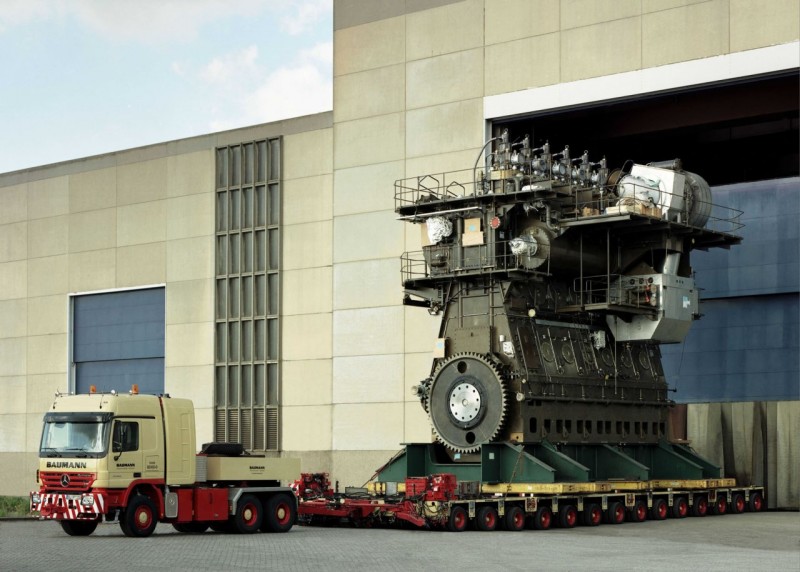Ginormous is a word penned by combining gigantic and enormous, two words that, if you’re not a mobile dictionary, mean essentially the same thing. Then why pen it in the first place? Well, it certainly seems necessary after you learn of a diesel engine so “ginormous” that they had to put walkways on it. The Wärtsilä RT-flex96C is a two-stroke turbocharged low-speed diesel engine designed by the Finnish manufacturer Wärtsilä. It is currently considered the largest reciprocating engine in the world, designed for large container ships, running on heavy fuel oil.How large do you need to make your baby to make all nuclear reactors doing the same job as it look puny and utterly incompetent? You just need to build one about 13.5 metres (44 ft) high, 27.3 m (90 ft) long, weigh over 2300 tonnes and churn out about 109000 horses worth of power.
Get this- The crankshaft weighs in at 300 tonnes, it consumes 160g (6.5 ounces) of fuel per cylinder per cycle and does so while maintaining more than 50 percent thermal efficiency (most engines operate at 25-30 percent efficiency, including the holy Bugatti Veyron with its “tiny” W 16 powerplant). Why on Earth would anyone build something like this? Maybe they did it just for the kick like I probably would if I had a couple of billion dollars lying around or they built a ship as huge as the Emma Mærsk (a ship that can carry 11000 20-foot containers, or quite simply the largest of its kind in the world) and wanted to push it from USA to China at a breakneck speed of 31 knots in comparison to other container ships that travel at 18-20 knots.
The 14-cylinder version was put into service in September 2006 aboard the Emma Mærsk. The design is based on the older RTA96C engine, but revolutionary common rail technology has done away with the traditional camshaft, chain gear, fuel pumps and hydraulic actuators. The result is better performance at low revolutions per minute(rpm), lower fuel consumption, and lower harmful emissions.
The engine has crosshead bearings so that the always vertical piston rod allows a tight seal under the piston. One of the reasons that the large two-stroke diesels use this design is so that thelubrication in the combustion area is separated from the crank case oil, which stays clean from combustion products. The upper portion is lubricated by continuous injection of consumable lubricant which is formulated to stand up to high temperatures and high sulfur. Another reason is to reduce sideways forces on the piston, keeping diametral cylinder liner wear in the order of only about 0.03 mm per 1000 hours.
The descending piston is used to compress incoming combustion air for the adjacent cylinders which also serves to cushion the piston as it approaches bottom dead centre (BDC) to remove some load from the bearings.
25 engines are in service with 86 on order.
Technical Data :
- Total engine weight: 2300 tons (The crankshaft alone weighs 300 tons.)
- Length: 89 feet
- Height: 44 feet
- Maximum power: 108,920 hp at 102 rpm
- Maximum torque: 5,608,312 lb/ft at 102rpm
- At its most efficient setting it consumes 1660 gallons of fuel per hour
- Engine Displacement: 1820 litres per cylinder
- Engine Speed : 22 to 102 Revolutions per minute
